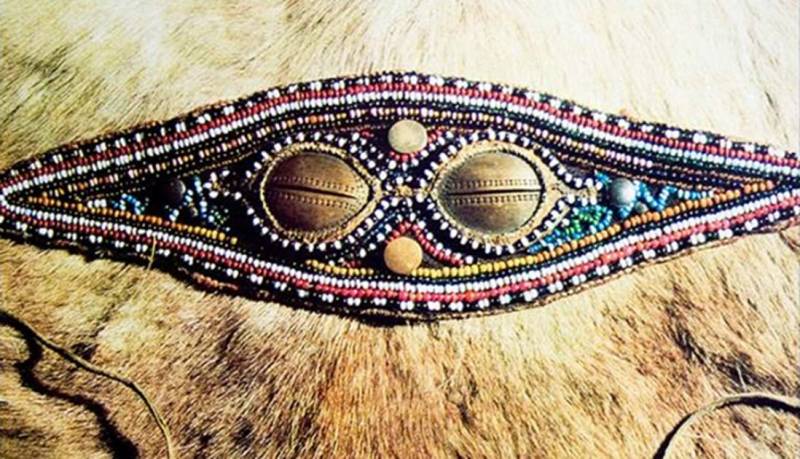
Siberian goggles are among the oldest in the world because the weather there requires protection from sunrays which can cause blindness otherwise. They have been in used since ancient times.
Sometimes they were crafted from silver but also from walrus teeth, leather, whalebone, wood, hair and bark. The softer materials were used in the most intense winters for their kindness to skin in the harsh weather. Most of their creaters were skills masters of either Eskimo groups or Chukchi people. These masters wanted to protect the eye while keeping in mind the appearance of the user. They tried to make their creations as fashionable as possible. Siberian hunters had to find this solution to the sun’s glare.
Googles made from metal have small cross-like slits so that the wearer can see through them while the rest of the eye is protected. Different ethnic groups in the region developed their own styles in these goggles.
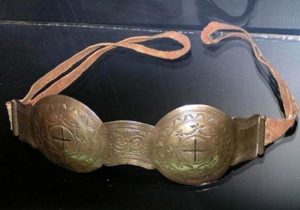
The oldest one belongs to Old Bering Sea culture which is located on both sides of the Bering Strait. The oldest date of the culture is about 400 years BC and it was obtained through the Ekven graveyard in Chukotka. The culture is said to have peaked in second and third centuries. Snow goggles made out of bone were found in the Ekven graveyard. They were also found in the Uelen graveyards and dated from the first to the fifth centuries AD.
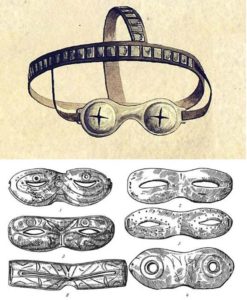
Some of these goggles were embellished with carvings.
The snow goggle tradition continued with Eskimos like Yupik, Inuit, and the Chukchi people. They made goggles from whalebone and ivory from extinct mammoths, wood and antler.
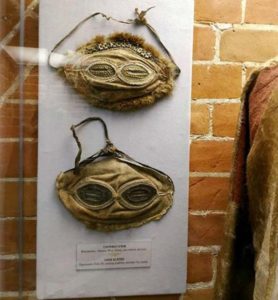
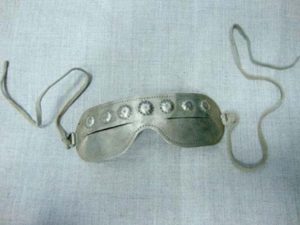
They sometimes painted the surface black to provide extra coverage from the sun.
Northern areas of Canada and US have similar eyewear traditions. A variation of the spectacles is said to have been used in traditional shamans, like the goggles without holes or slits in Ekven.
The Evenks and Dolgans peple started using metal like copper, silver, tin and inserted it into a half-mask made out of reinder skin or later cloth from Russia. They decorated these goggled with beads. Nganasan and Khanty used similar glasses and the British Museum has some samples of these.
The culture continues till today and is thriving in Yakutia, also known as Sakha Republic, the largest region in Russia.

The Yakut people used a wide range of materials for their goggles, like birch bark, wood, metal, bone, skin and horsehair. The goggled created from horsehair has intricate strips. A sample surviving from the 19th Century belongs to Tuva, a mountaneous region in southern Siberia. It is available in the Irkutsk Museum of Local History. Most of the metal goggles found in Yakut collections come from 18th to 20th century. These were designed by shamans for days in the snow. Many Yakuts still reminisce about the simple goggles their grandfathers wore made of birch bark. These older goggles were simple and had a small metal strip or depression for the nose. There were slots to make vision possible. A modern version of these goggles is made of silber with cross-shaped slits and fur lining. The silver eyewear inspires local designers and photographers in Yakutia.
One local historian Prokopy Nagovitsyn said: “The round shaped silver goggles began to make an appearance in 19th century, when they appealed to many rich people. The shape had a symbolic meaning - cross in the circle had been the symbol of the sun since Neolithic times. Yet the cross-shaped cuts are convenient not when you are in tundra, but when you, for example, climb steps.”
“Such goggles were also used by shamans. People believed that when a man became a shaman, he could have kill[ed] with the might of his look, so these goggles could have been seen as a protective shield.”
Sometimes they were crafted from silver but also from walrus teeth, leather, whalebone, wood, hair and bark. The softer materials were used in the most intense winters for their kindness to skin in the harsh weather. Most of their creaters were skills masters of either Eskimo groups or Chukchi people. These masters wanted to protect the eye while keeping in mind the appearance of the user. They tried to make their creations as fashionable as possible. Siberian hunters had to find this solution to the sun’s glare.
Googles made from metal have small cross-like slits so that the wearer can see through them while the rest of the eye is protected. Different ethnic groups in the region developed their own styles in these goggles.

The oldest one belongs to Old Bering Sea culture which is located on both sides of the Bering Strait. The oldest date of the culture is about 400 years BC and it was obtained through the Ekven graveyard in Chukotka. The culture is said to have peaked in second and third centuries. Snow goggles made out of bone were found in the Ekven graveyard. They were also found in the Uelen graveyards and dated from the first to the fifth centuries AD.

Some of these goggles were embellished with carvings.
The snow goggle tradition continued with Eskimos like Yupik, Inuit, and the Chukchi people. They made goggles from whalebone and ivory from extinct mammoths, wood and antler.


They sometimes painted the surface black to provide extra coverage from the sun.
Northern areas of Canada and US have similar eyewear traditions. A variation of the spectacles is said to have been used in traditional shamans, like the goggles without holes or slits in Ekven.
The Evenks and Dolgans peple started using metal like copper, silver, tin and inserted it into a half-mask made out of reinder skin or later cloth from Russia. They decorated these goggled with beads. Nganasan and Khanty used similar glasses and the British Museum has some samples of these.
The culture continues till today and is thriving in Yakutia, also known as Sakha Republic, the largest region in Russia.

The Yakut people used a wide range of materials for their goggles, like birch bark, wood, metal, bone, skin and horsehair. The goggled created from horsehair has intricate strips. A sample surviving from the 19th Century belongs to Tuva, a mountaneous region in southern Siberia. It is available in the Irkutsk Museum of Local History. Most of the metal goggles found in Yakut collections come from 18th to 20th century. These were designed by shamans for days in the snow. Many Yakuts still reminisce about the simple goggles their grandfathers wore made of birch bark. These older goggles were simple and had a small metal strip or depression for the nose. There were slots to make vision possible. A modern version of these goggles is made of silber with cross-shaped slits and fur lining. The silver eyewear inspires local designers and photographers in Yakutia.
One local historian Prokopy Nagovitsyn said: “The round shaped silver goggles began to make an appearance in 19th century, when they appealed to many rich people. The shape had a symbolic meaning - cross in the circle had been the symbol of the sun since Neolithic times. Yet the cross-shaped cuts are convenient not when you are in tundra, but when you, for example, climb steps.”
“Such goggles were also used by shamans. People believed that when a man became a shaman, he could have kill[ed] with the might of his look, so these goggles could have been seen as a protective shield.”
